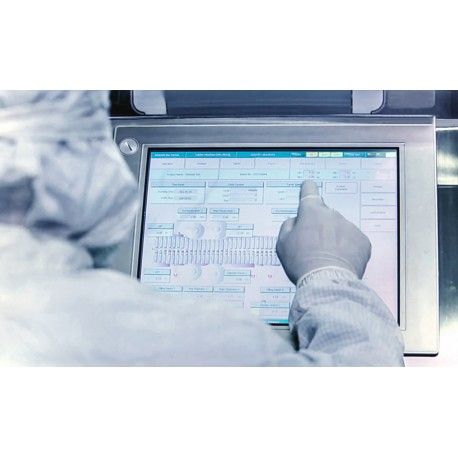Introduction:
In the dynamic world of pharmaceuticals, the integration of computerized systems is not just a technological advancement; it's a critical component ensuring patient safety, product quality, and data integrity. Let's delve into the intricacies of Good Manufacturing Practice (GMP) standards, demystifying the key elements that govern the development, operation, and maintenance of computerized systems.

Definition of Computerized Systems: Bridging Hardware and Software:
GMP standards define a computerized system as a set of software and hardware components which together fulfill certain functionalities. EU GMP Eudralex Annex 11- Principle
Ensuring Data Accuracy: Built-in Checks and Risk Management:
Computerised systems exchanging data electronically with other systems should include appropriate built-in checks for the correct and secure entry and processing of data, in order to minimize the risks. EU GMP Eudralex Annex 11- 5
This definition sets the stage for understanding the meticulous requirements laid out to guarantee the reliability and security of these systems.
Data Security: A Multi-faceted Approach
GMP standards place paramount importance on securing data against damage.
Physical and/or logical controls should be in place to restrict access to computerised system to authorised persons. Suitable methods of preventing unauthorised entry to the system may include the use of keys, pass cards, personal codes with passwords, biometrics, restricted access to computer equipment and data storage areas. EU GMP Eudralex Annex 11- 12.1
Audit Trails: Transparency and Accountability
Consideration should be given, based on a risk assessment, to building into the system the creation of a record of all GMP-relevant changes and deletions (a system generated "audit trail").
For change or deletion of GMP-relevant data the reason should be documented. Audit trails need to be available and convertible to a generally intelligible form and regularly reviewed. EU GMP Eudralex Annex 11- 9
User Requirements and Design: A Blueprint for Success
User Requirements Specifications, derived from documented risk assessments and GMP impact analyses, serve as the blueprint for the computerized system.
User Requirements Specifications should describe the required functions of the computerised system and be based on documented risk assessment and GMP impact. User requirements should be traceable throughout the life-cycle. EU GMP Eudralex Annex 11- 4.4
Validation Testing: Ensuring Fitness for Purpose
GMP related computerized systems should be validated. The depth and scope of validation depends on the diversity, complexity and criticality of the computerized application. EU GMP ICH Q7A- 5.40
Validation Plan:
A computerized system validation plan becomes the guiding document.
Validation plan should be produced for each GxP regulated computerized system, focusing on aspects related to patient safety, product quality, and data integrity. It should summarize the entire project, identify measures for success, and clearly define criteria for final acceptance and release of the system. ISPE GAMP 5 A Risk-Based Approach to Compliant GxP Computerized Systems- 5.1
Testing and Release: Meeting Regulatory Standards:
Appropriate installation and operational qualifications should demonstrate the suitability of computer hardware and software to perform assigned tasks. EU GMPICH Q7A- 5.41
Summary Report:
At the conclusion of the project, a computerized system validation report should be produced summarizing the activities performed, any deviations from the plan, any outstanding and corrective actions, and providing a statement of fitness for intended use of the system. ISPE GAMP 5 A Risk-Based Approach to Compliant GxP Computerized Systems- 6.2.10
Business Continuity and Disaster Recovery: Proactive Planning
Within the broader scope of business continuity planning, specific plans for system recovery in the face of disasters are highlighted. These plans detail precautions to minimize the impact of disasters, with a focus on prevention and redundancy for critical systems.
System Inspection:
Inspectors assess potential risks associated with the automated system, relying on the regulated user's documented risk assessment.
The regulated user’s range of computerised systems needs to be formally listed in an inventory and the scope/extent of validation for each detailed in a consolidated written Validation programme. EU GMP PICs PI011-3- 14.3
Conclusion: A Holistic Approach to Compliance
As we navigate the intricate landscape of GMP standards for computerized systems, it becomes evident that compliance is not a mere formality but a holistic approach to ensuring the highest standards of quality, safety, and data integrity in pharmaceutical manufacturing.
In embracing these standards, pharmaceutical companies not only meet regulatory requirements but also contribute to the advancement of a digital landscape that prioritizes patient well-being and product excellence.
References
1. ICH Topic Q 7 Good Manufacturing Practice for Active Pharmaceutical Ingredients
2. EudraLex, Volume 4, Part 1 Annex 11: Computerised Systems
3. FDA, 21 CFR Part 11: Complete Guide to International Computer Validation
4. ISPE GAMP 5 A Risk-Based Approach to Compliant GxP Computerized Systems
5. EU GMP PICs PI011-3- 14.3